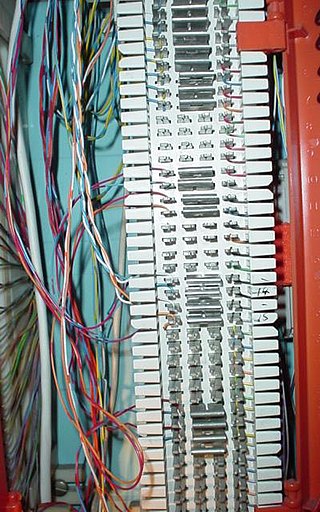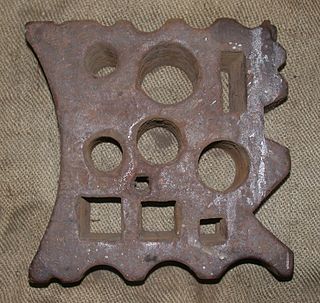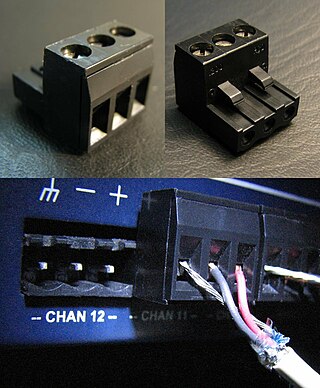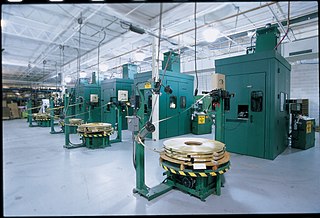
In telecommunications, RS-232 or Recommended Standard 232 is a standard originally introduced in 1960 for serial communication transmission of data. It formally defines signals connecting between a DTE such as a computer terminal, and a DCE, such as a modem. The standard defines the electrical characteristics and timing of signals, the meaning of signals, and the physical size and pinout of connectors. The current version of the standard is TIA-232-F Interface Between Data Terminal Equipment and Data Circuit-Terminating Equipment Employing Serial Binary Data Interchange, issued in 1997. The RS-232 standard had been commonly used in computer serial ports and is still widely used in industrial communication devices.

In telephony, a main distribution frame is a signal distribution frame for connecting equipment to cables and subscriber carrier equipment.

Rigging comprises the system of ropes, cables and chains, which support a sailing ship or sail boat's masts—standing rigging, including shrouds and stays—and which adjust the position of the vessel's sails and spars to which they are attached—the running rigging, including halyards, braces, sheets and vangs.

Components of an electrical circuit are electrically connected if an electric current can run between them through an electrical conductor. An electrical connector is an electromechanical device used to create an electrical connection between parts of an electrical circuit, or between different electrical circuits, thereby joining them into a larger circuit. Most electrical connectors have a gender – i.e. the male component, called a plug, connects to the female component, or socket. The connection may be removable, require a tool for assembly and removal, or serve as a permanent electrical joint between two points. An adapter can be used to join dissimilar connectors.

Standing rigging comprises the fixed lines, wires, or rods, which support each mast or bowsprit on a sailing vessel and reinforce those spars against wind loads transferred from the sails. This term is used in contrast to running rigging, which represents the moveable elements of rigging which adjust the position and shape of the sails.

Swaging is a forging process in which the dimensions of an item are altered using dies into which the item is forced. Swaging is usually a cold working process, but also may be hot worked.

A 66 block is a type of punch-down block used to connect sets of wires in a telephone system. They have been manufactured in four common configurations, A, B, E and M. A and B styles have the clip rows on 0.25" centers while E and M have the clip rows on 0.20" centers. The A blocks have 25 slotted holes on the left side for position the incoming building cable with a 50 slot fanning strip on the right side for distribution cables. They have been obsolete for many years. The B & M styles have 50 slot fanning strip on both sides. The B style is used mainly in distribution panels where several destinations need to connect to the same source. The M blocks are often used to connect a single instrument to such a distribution block. The E style has 5 columns of 10 2 clips rows and are used for transitioning from the 25 pair distribution cable to a 25 pair RJ21 style female ribbon connector.

A 110 block is a type of punch-down block used to terminate runs of on-premises wiring in a structured cabling system. The designation 110 is also used to describe a type of insulation displacement contact (IDC) connector used to terminate twisted pair cables, which uses a punch-down tool similar to the type used for the older 66 block.

A swage block is a large, heavy block of cast iron or steel used in smithing, with variously-sized holes in its face and usually with forms on the sides.

A binding post is a connector commonly used on electronic test equipment to terminate (attach) a single wire or test lead. They are also found on loudspeakers and audio amplifiers as well as other electrical equipment.

A cable harness, also known as a wire harness, wiring harness, cable assembly, wiring assembly or wiring loom, is an assembly of electrical cables or wires which transmit signals or electrical power. The cables are bound together by a durable material such as rubber, vinyl, electrical tape, conduit, a weave of extruded string, or a combination thereof.

A modular connector is a type of electrical connector for cords and cables of electronic devices and appliances, such as in computer networking, telecommunication equipment, and audio headsets.

A screw terminal is a type of electrical connection where a wire is held by the tightening of a screw.
In 1973 Sta-Lok launched the swageless terminal system for wire rope at the London Boat Show.

In electrical and electronic engineering, a daisy chain is a wiring scheme in which multiple devices are wired together in sequence or in a ring, similar to a garland of daisy flowers. Daisy chains may be used for power, analog signals, digital data, or a combination thereof.

A rivet nut, also known as a blind rivet nut, or rivnut, is a one-piece internally threaded and counterbored tubular rivet that can be anchored entirely from one side. It is a kind of threaded insert. There are two types: one is designed to form a bulge on the back side of the panel as a screw is tightened in its threads. The other is similarly drawn in using a screw, but is drawn into the sleeve instead of creating a bulge.

Euroblock, short for "European-style terminal block", is an extra-low voltage disconnectable connector and terminal block combination commonly used for microphone- and line level-audio signals, and for control signals such as RS-232 or RS-485.
Strudyna, also known as Structural Dynamics Co., Ltd, is a renowned engineering and manufacturer of Stainless Steel Tensile Components for facade structures, with offices and fabrication facilities in the UK, Australia and Thailand, and manufacturing facilities in Thailand.

ETCO, Incorporated is a privately held, American Company based in Bradenton, Florida. Founded in 1947, it is now one of the oldest privately held manufacturing corporations in the United States. Some of ETCO's major areas of operation include manufacturing of wall socket, auto parts, custom metal parts, precision metal stampings for appliances and other metal based products. In 2011, it merged operations of its North and South divisions while maintaining two autonomous manufacturing locations based in Warwick, Rhode Island, and Bradenton, Florida.
















